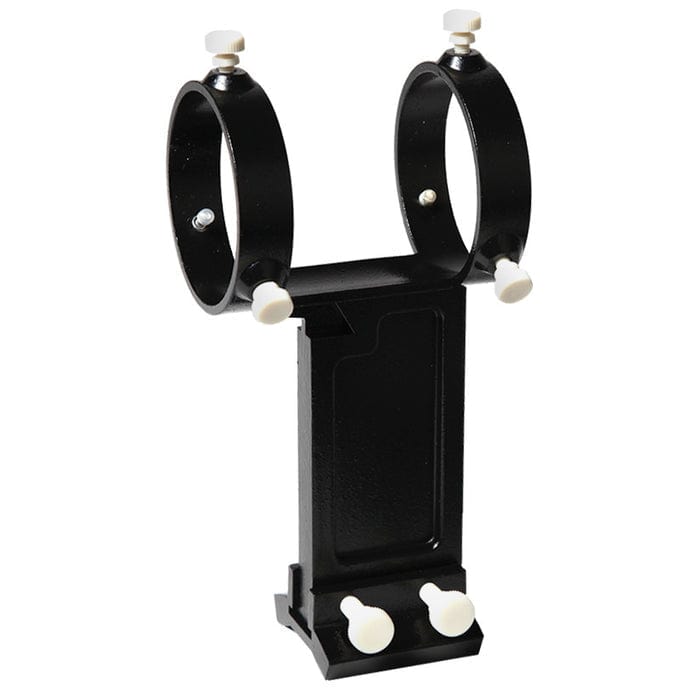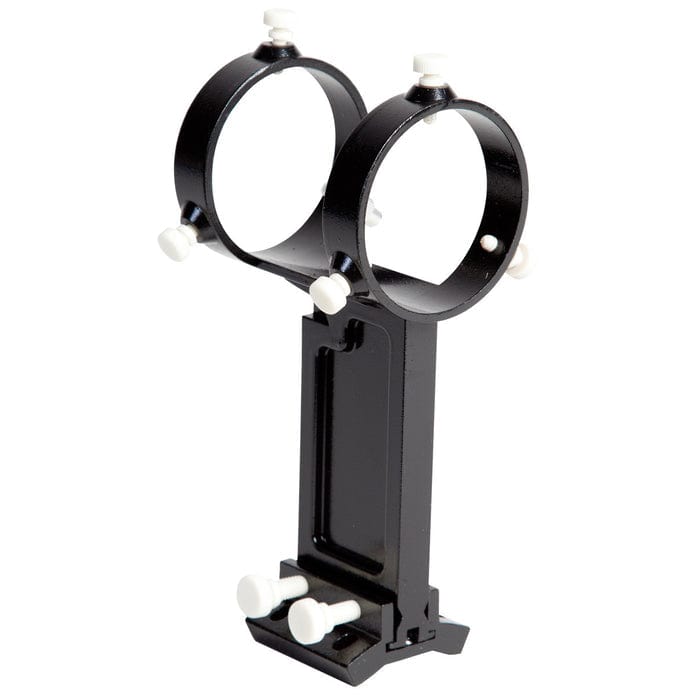Description
Explore Scientific finder scope rings are all made for 50mm finders. Choose from a classic low profile bracket (about an inch tall), one that is a tad higher (1.5") or a high profile bracket that stands 4" above the finder scope base.
Regardless of the height you choose, these brackets have two rings to hold your finder firmly yet gently, and each ring has three adjustment points. Heavy-duty plastic thumbscrews are included, and have large heads for easy adjustment even if you're wearing gloves.
Because your telescope may not fit in its case with the finder scope attached, you will appreciate the quick release feature on Explore Scientific finder brackets. The bracket itself dovetails into a bracket, and locks down with thumbscrews. It is a simple thing to remove or install your finder and bracket on your telescope in this manner.
To install your finder into the bracket, simply back the thumbscrews out so that you've opened up the full inside diameter of the rings. Slide the finder into place, and adjust the screws inward until your finder scope is securely held in position. You should have very rough alignment at this point, which means when you look through the finder and center an object, and then look through a low power eyepiece inserted in your telescope diagonal or focuser, that object will most likely be in the field of view, but not at or near the center (unless you are very lucky!). Doing that first fine alignment…the task of matching what's in your finder to what's in your eyepiece…can be tedious and frustrating sometimes, but once you complete the job, it should never be required again. Sure, you will have to tweak the adjustment every time you re-install the finder/bracket combo onto your telescope, but it should be fairly quick and simple.
Here is a helpful hint when it comes time to do that first alignment. Set your telescope up in the daytime, and make sure you bring out a variety of eyepieces with you. Find an easy target that is relatively far away, like a streetlight or the top of a telephone pole. Starting with the lowest power eyepiece, adjust your finder bracket until you have "matching" views. The more accurate you are, the easier it will be when you trade out your low power eyepiece for something a little stronger.
Now do just that; put in a medium-powered eyepiece and do the same thing, being as accurate as you can. Finally, it's time for the high-powered eyepiece. Once you have finished this alignment process, you can either wait for the sun to go down to finish tweaking your finder, or you can put your telescope away and wait until the next time. Either way, once it is dark, find something bright, like the Moon or Venus or Jupiter, and center it in your finder. Now install the medium-powered eyepiece and check your view. If the object is not centered, make your adjustments, then insert the high-powered eyepiece and check again. Once you have made the necessary tweaks, you are good to go. From now on, unless you remove the finder from the bracket or something else happens to severely change alignment, you should only have to make small tweaks before every observing session. I know it sounds like a lot of trouble to go through for such a "small" thing, but trust me, I have seen more beginners make the mistake of trying to do finder alignments in the dark on small, dim objects, and it is not a pretty sight! All they want to do is observe, and they feel like they are wasting precious time doing silly things. A well-aligned finder makes astronomy SO much easier…give yourself a break and do the hard part during the day, and you won't be sorry!
Specifications
| Item Number | FNDRRGSTALL |
| Weight | 7oz; 198.4g |
| Length | 73mm |
| Width | 61mm |
| Height | 115mm |



